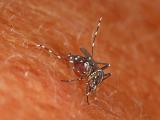Apr 11, 2011
US extends contract for freeze-dried Imvamune smallpox vaccine
The US government has extended its contract with the Danish company Bavarian Nordic to develop a freeze-dried version of its Imvamune smallpox vaccine, increasing the contract's value from $40 million to $94 million, the company announced today. The expanded contract provides funds to validate the manufacturing process for the freeze-dried vaccine and for related preclinical and clinical studies. Imvamune involves a weakened version of vaccinia virus and is intended for people at risk for serious complications from the conventional smallpox vaccine. The company said the freeze-dried formulation of the vaccine offers potentially longer shelf life than the existing liquid frozen version and would also "improve cold chain logistics during shipment." Deliveries of the first 20 million doses of the existing vaccine to the US Strategic National Stockpile are ongoing, the company noted. The firm said it has been awarded a total of $740 million in US contracts for developing and supplying Imvamune.
Apr 11 Bavarian Nordic press release
Alabama hospital infections linked to tainted faucet at pharmacy
Alabama health officials recently said a failure in the sterilization process at a Birmingham pharmacy apparently caused the contamination of a liquid nutrition mixture that led to Serratia marcescens infections in 19 hospital patients, 9 of whom died, according to local media reports. State Health Officer Don Williamson said a strain of S marcescens found on a faucet, a container, and a device used to mix total parenteral nutrition (TPN) matched the strain found in 12 patients, the Birmingham News reported Apr 8. The infections occurred at five hospitals in the Birmingham area and one in Prattville, all of which received TPN from Meds IV pharmacy. Williamson said the Meds IV staff used tap water to wash the mixing container before rinsing it with sterile water, according to the report. An amino acid solution was also found contaminated with S marcescens, probably from contact with the equipment. The solution was supposed to be run through a filter fine enough to catch bacteria, but that step failed, for unknown reasons, Williamson said. He said the investigation was continuing and could take weeks.
Apr 8 Birmingham News story
Mar 30 US Food and Drug Administration (FDA) safety alert
FDA approves first test for dengue fever
The FDA announced its approval of the first test for diagnosing dengue virus infection. The test, DENV Detect IgM Capture ELISA, detects antibodies to dengue virus in blood samples from people who have signs and symptoms of the disease, the FDA said on Apr 8. The test is based on technology patented by the Centers for Disease Control and Prevention (CDC) and is made by Inbios Inc. of Seattle. The FDA said diagnostic testing for dengue is complicated by the fact that IgM antibodies are not detectable until 3 to 5 days after the onset of fever, and there are no approved tests for detecting the virus itself. The new test cross-reacts with other viruses closely related to dengue, including West Nile virus, but in most situations in the United States, "a positive test result in a patient with signs or symptoms consistent with dengue should be considered presumptive evidence of dengue," the FDA said. Dengue fever is common in tropical countries, and dozens of cases were reported in Florida last year.
Apr 8 FDA statement
3-state E coli outbreak definitively linked to California hazelnuts
The CDC on Apr 7 filed its final report on a three-state outbreak of Escherichia coli infections linked to hazelnuts, raising the number of infected persons by one, to eight. Since the CDC's previous outbreak report Mar 10, an additional case was confirmed in Wisconsin, yielding 4 cases there, 3 in Minnesota, and 1 in Michigan. Patients ranged in age from 15 to 78 years, with a median of 63 and all but 2 male. Four required hospitalization, with the latest date of illness onset being Feb 16. On Mar 4 DeFranco and Sons of Los Angeles recalled bulk and smaller packages of hazelnuts because of possible E coli O157:H7 contamination. At that time testing had not implicated DeFranco hazelnuts, but the recent CDC report said, "Laboratory testing conducted by the Minnesota Department of Agriculture on in-shell hazelnuts, the California Department of Public Health on mixed nuts containing in-shell hazelnuts, and the Wisconsin Department of Health Services on mixed nuts containing in-shell hazelnuts identified E coli O157:H7 matching the outbreak strain by DNA analysis."
Apr 7 CDC report
Mar 5 DeFranco & Sons recall notice
C difficile test cleared by FDA
The FDA recently cleared for marketing a test for detecting Clostridium difficile infection, including an epidemic strain associated with increased disease severity. The test, called the "Cepheid Xpert C. difficile/Epi" assay, can help detect C difficile in a patient's stool, including the epidemic 027/NAP1/BI strain. The assay "is automated and works on the Cepheid GeneXpert Dx System to detect toxin gene sequences associated with toxigenic C. difficile," according to an FDA news release. The release states that those most at risk of contracting C difficile are the elderly, patients in hospitals and nursing homes, and patients taking antibiotics for another infection.
Apr 8 FDA news release
UK researchers find GP data tracking useful for H1N1 pandemic
Researchers from the UK Health Protection Agency (HPA) report that a surveillance system using data collected from general practitioners (GPs) was useful in tracking regional differences in pandemic 2009 H1N1 influenza. The researchers analyzed symptom and prescribing data from Apr 27, 2009, to Jan 28, 2010, in the HPA/QSurveillance system, which monitors 3,400 GP offices covering more than 23 million people. They found it a useful tool to model "real time" national weekly case estimates and geographical discrepancies. They identified week 30 (Jul 19 to 25) to be the peak of the pandemic's wave in Great Britain, with London and the West Midlands hit the hardest.
Apr 8 Epidemiol Infect abstract


















